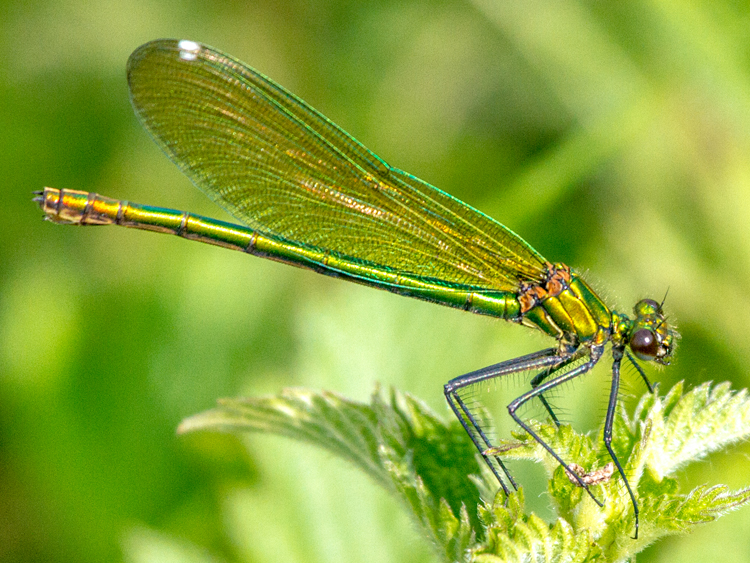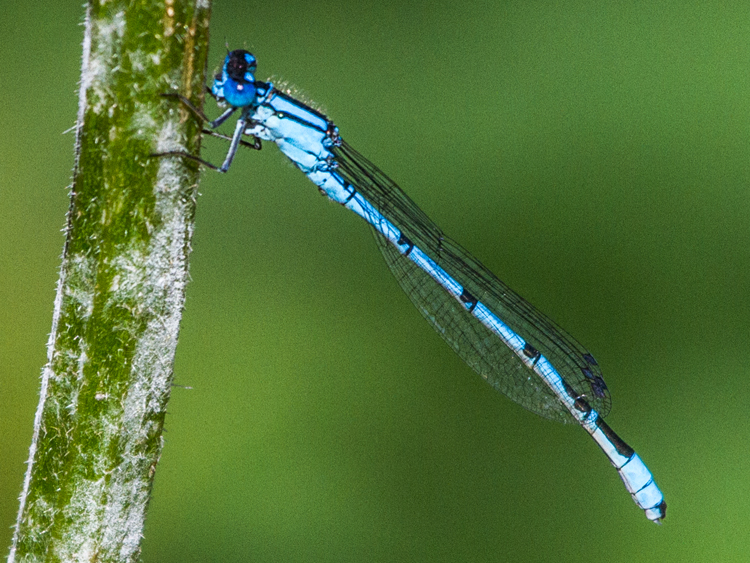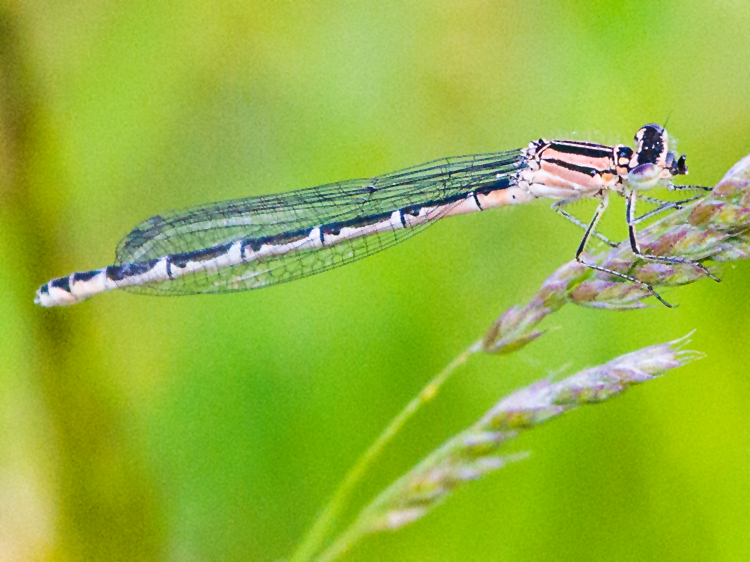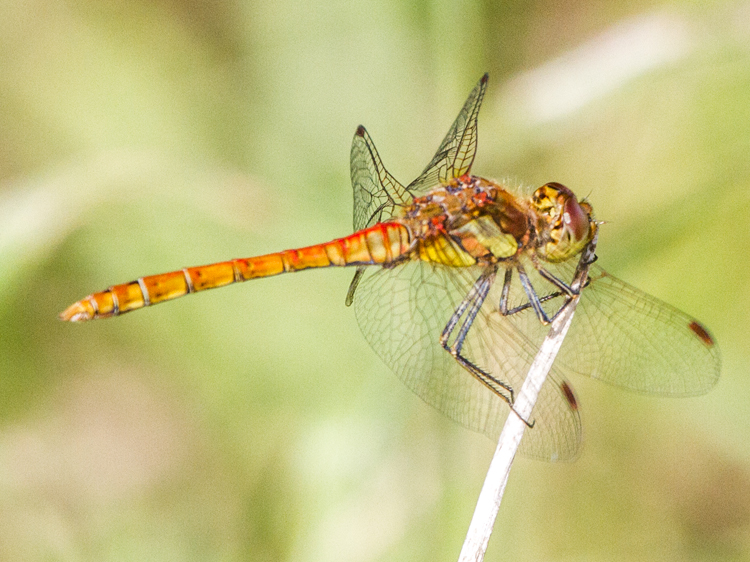Wildlife at the North Elmham Cathedral Meadows
Dragonflies
Species recorded since April 2018: 14.
Coverage: Moderate - visits during their flight season are far from daily and don’t necessarily coincide with suitable weather for recording dragonflies, and may not be at the best times of day. However, every dragonfly that is seen well enough to identify is recorded. Most species are readily identified when seen well but dragonflies are often seen too fleetingly to identify and record.
All photos below are of insects found at the Cathedral Meadows.
DEMOISELLES (family CALOPTERYGIDAE)
Banded Demoiselle Calopteryx splendens
Common in Norfolk, perhaps nowhere more so than along the River Wensum. Can occasionally be encoutered anywhere at the Cathedral Meadows but most often seen along the railway and at bottom of North Field.
.jpg)

male and female Banded Demoiselles, 1st June 2020 and 27th May 2020
DAMSELFLIES (family COENAGRIONIDAE)
Blue-tailed Damselfly Ischnura elegans
A common damselfly in Norfolk but so far proving surprisingly hard to find at the Cathedral Meadows. So far only seen along the railway and at the bottom of North Field.
Blue-tailed Damselfly, 6th June 2018
Common Blue Damselfly Enallagma cyathigerum
A very common damselfly in Norfolk and one of the two commonest species at the Cathedral Meadows.


Common Blue Damselflies, 15th August 2019 and 27th May 2020 (second individual is teneral, i.e. recently-emerged)
Azure Damselfly Coenagrion puella
Another very common damselfly in Norfolk and one of the two commonest species at the Cathedral Meadows.
.JPG)
.jpg)
male and female Azure Damselflies, 27th June 2018 and 15th May 2020
Large Red Damselfly Pyrrhosoma nymphula
Common in Norfolk and usually the first dragonfly to emerge in spring. Common at the Cathedral Meadows between late April and early June and can be seen pretty much anywhere.
 (2).jpg)

Large Red Damselflies, 24th April 2020 and 27th May 2020
HAWKERS and EMPERORS (family AESHNIDAE)
Migrant Hawker Aeshna mixta
A common dragonfly in Norfolk – the resident population is often supplemented by large numbers of migrants from the Continent. Seen most years at the Cathedral Meadows but in varying numbers.
 (3).jpg)
 (2).jpg)
Migrant Hawkers, 3rd August 2019
Brown Hawker Aeshna grandis
A fairly common dragonfly in Norfolk easily recognised by its brown-suffused wings. Seen at the Cathedral Meadows in low numbers numbers.
Southern Hawker Aeshna cyanea
A common dragonfly in Norfolk. Seen at the Cathedral Meadows on a small number of occasions, although other brief glimpses of large hawkers were suspected as being this species.
 (6).JPG)
Southern Hawker, 6th August 2018
Emperor Anax imperator
Our largest dragonfly in Norfolk. Sometimes seen at the Cathedral Meadows including a good count of 6 on 21st June 2019 when they were individually disturbed when walking through long grass in the lower meadows.
Hairy Dragonfly Brachytron pratense
Fairly common in Norfolk - this species flies earlier in the year than the other larger species. A brief flight view of one over the railway in May 2021.
CHASERS, SKIMMERS and DARTERS (family LIBELLULIDAE)
Four-spotted Chaser Libellula quadrimaculata
A common dragonfly in Norfolk but so far only identified once at the Cathedral Meadows.
Four-spotted Chaser, 13th June 2018
Black-tailed Skimmer Orthetrum cancellatum
Another common dragonfly in Norfolk that has so far only been identified twice at the Cathedral Meadows. Although the female below was perched vertically in grass this species is more often encountered resting horizontally on bare ground. In their prime, males have blue abdomens with black at the tip.

 (3).jpg)
male and female Black-tailed Skimmers, 4th August 2021 and 21st June 2019
Ruddy Darter Sympetrum sanguineum
Widespread in Norfolk but seems to be quite local – very numerous at a few good places but relatively scarce elsewhere. Three recorded at the Cathedral Meadows in 2018 gave hope that it would turn out to be common here, but none were seen in 2019 or 2020. The males are a deeper more blood-red colour than Common Darters, with a narrower waist.
female-type Ruddy Darter, 5th July 2018
Common Darter Sympetrum striolatum
At most places the commonest darter in Norfolk, and in fact often the commonest dragonfly; continues flying later in the year than other species (often seen on warm November days for example). Regularly recorded at the Cathedral Meadows.
.JPG)


male, teneral (recently-emerged) male and female Common Darters, 30th August 2018, 15th August 2019 and 29th July 2019

 (2).JPG)
 (3).JPG)
 (8).JPG)
 (1).JPG)
 (1).JPG)
.JPG)